A/C ENERGY SOURCES - Air Conditioning System Type by Energy Source
Air conditioning systems use these common energy sources to physically cool the condensing coils and thus the refrigerant
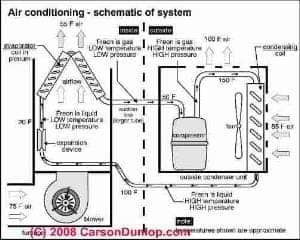 Air-cooled air conditioner systems: refers to the use of air to cool the compressor and the condenser coil used to return the refrigerant gas to a liquid state. Air-cooled air conditioner systems: refers to the use of air to cool the compressor and the condenser coil used to return the refrigerant gas to a liquid state.
These split systems usually have an inside evaporator cooling coil installed to work along with the blower and duct system which might also be sitting atop a heating furnace. The outside half of the equipment contains the compressor and condenser coil.
Carson Dunlop's schematic shows how refrigerant moving through the system as a gas or liquid moves heat from inside the building (at the evaporator coil in an air handler) to outside the building (at the condenser unit's condensing coil).
The schematic of an air-cooled air conditioning system shown at left is compliments of Carson Dunlop
|
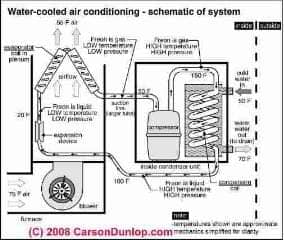
Water cooled air conditioning systems: these work in a manner similar to the system listed above, but use water as a chiller to remove heat from the high temperature gas in the (usually but not always outside) compressor/condenser unit.
The schematic of a water cooled air conditioning system shown at left is compliments of Carson Dunlop
As with the air-cooled air conditioning system above, this schematic describes an air conditioner that uses refrigerant and coils to move heat from indoors to outside. But instead of moving heat from the condensing coil into air blown across the coil outdoors, we're moving heat into water circulated around a condensing coil.
|
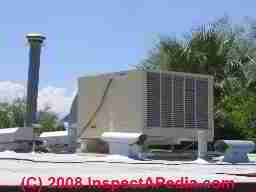
Evaporative coolers, also called "swamp coolers" rely on the evaporation of water to cool building air, rather than the movement of a refrigerant through cooling coils.
Cooling towers, swamp coolers, and even a simple window fan blowing air across a pan of water and into a room are types of evaporative cooling systems.
Swamp coolers systems may use less energy than a refrigerant-gas and compressor type air conditioner but they'll only work where the ambient humidity is low enough to make it easy to evaporate water, such as in Arizona and other areas of the Southwest and Mexico.
We discuss evaporative coolers in more detail at EVAPORATIVE COOLING SYSTEMS. |
Gas Chiller Air Conditioning Systems: these systems operate by the same principles as the above units, but they use heat to cause the refrigerant gas to change states rather than compression and expansion by a compressor motor. (Some refrigerators, including ones used in recreational vehicles also operate on this principle, as they can cool without requiring electricity to operate a compressor. Ammonia was the traditional gas used for this type of system.)
Photographs of Types of Air Conditioning Systems
Photos of Typical Residential Central Air Conditioning System
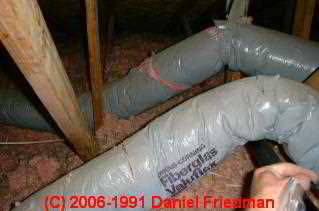 The most common central residential air conditioning system incorporates an indoor air handler unit or AHU which draws building air through return ducts from the living space, cools it by moving the air across an evaporator coil, and sends cooled and dehumidified air back into the living area through supply ducts and registers. The most common central residential air conditioning system incorporates an indoor air handler unit or AHU which draws building air through return ducts from the living space, cools it by moving the air across an evaporator coil, and sends cooled and dehumidified air back into the living area through supply ducts and registers.
Liquid refrigerant is released into the interior of the evaporator coil, changing its state from liquid to gas and thereby cooling the evaporator coil (which in turn cools and dehumidifies air which is blown across the coil).
Refrigerant used to cool the evaporator coil runs in independent piping, usually copper, from the evaporator coil outside to a compressor and condenser unit where the refrigerant is repressurized, cooled, and returned back inside to the evaporator coil as a liquid. The photos (above) show a basement AHU, an outdoor compressor/condenser, and flex-duct in an attic. |
In the above-left photo, the basement AHU has been retrofitted with an air conditioning unit which by simple inspection is probably improperly designed and mismatched to the size and air flow character of the original air handler - notice how the A/C plenum is much larger than the blower compartment.
In the above-right photo the compressor unit looks OK on casual inspection but there seems to be no pad, the unit is slightly tipped, and while we can't see the refrigerant lines, that taut electrical wire makes me wonder if there is a lack of extra slack (a loop) in the refrigerant lines to permit movement - a refrigerant leak and system failure may be coming soon.
In the third photo above, this particular flex duct product, one previously produced by Owens Corning(R) is defective and disintegrates on exposure to hot areas. [Owens Corning flex duct failure photo courtesy of
Mark Cramer Tampa FL]
Photos of the Attic Air Handler Unit for Central Air Conditioning
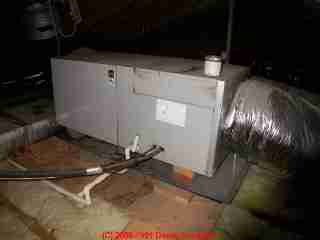 Attic air conditioning equipment for residential air conditioning systems includes an air handler unit such as the one shown in this photo, combined with an outside compressor/condenser such as the one shown earlier above. Attic air conditioning equipment for residential air conditioning systems includes an air handler unit such as the one shown in this photo, combined with an outside compressor/condenser such as the one shown earlier above.
Attic-mounted central air equipment may have different defects and problems than a similar unit located in a lower building floor or basement.
The residential central air conditioning equipment components are the same in an attic unit as a typical basement unit except that they are arranged horizontally rather than vertically. |
Photos of Independent Systems or Ductless Air Conditioning or Heat Pumps
Ductless air conditioning systems do not make use of an air handler connected to duct work to distribute conditioned air the for central cooling and/or heating. These include ductless systems mounted on roofs or in attics and wall-mounted units (shown here) which may typically an indoor fan and evaporator coil to produce cooled and dehumidified air, but which route refrigerant to an outside compressor/condenser unit.
Photos of Wall convector units for heating and air conditioning
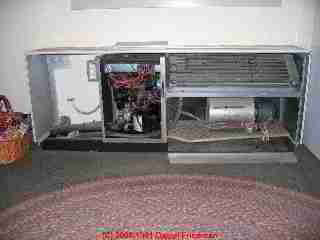
Wall convectors are often used for both heating and cooling in commercial installations and high-rise apartment buildings. The unit shown has its own compressor mounted right in the cabinet, visible at lower center in the photo.
Wall-mounted heating and cooling convector installations may be designed with one central heater or cooling system which feeds multiple units with chilled or heated water or possibly refrigerant from a single remote heating and cooling heat pump. |
Another common residential alternative dispenses with duct work entirely, using a wall-mounted indoor evaporator/blower unit and a separate outside compressor/condenser. In this latter split design, one compressor/condenser may serve multiple wall-mount indoor units.
Photos of Commercial rooftop-mounted combined air conditioning or heat pump units
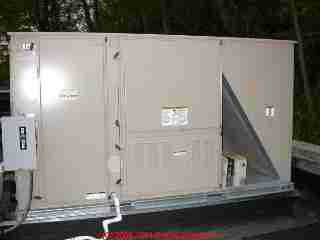
Rooftop mounted central air conditioning systems may include both the cooling unit (evaporator coil, blower fan, filters) and the compressor/condenser unit in one package.
Rooftop mounted central cooling systems may be smaller packaged systems which blow their cool air down directly into the cooled space through an opening in the roof, drawing return air from a nearby location, or the rooftop cooling system may be connected to duct work which in turn blows down into multiple building areas to deliver cool air, drawing return air from one or more centralized returns. In many commercial installations, the entire area over a suspended ceiling may serve as one giant return plenum through which pass the supply ducts, delivering air to individual supply registers.
While the list above describes the common components of a typical residential air conditioning system, other configurations and packaged units are also in increased use in both residential and commercial installations. Alternative designs may combine all components except for the duct work in a rooftop mounted unit such as the one shown above where it was mounted on a flat roof over offices at a commercial building.
Photos of Window or Wall-Mounted or Portable Room Air Conditioners
The window-mounted air conditioner in these photographs is a small 8,000 BTUh unit but it was installed in a strategic location at the top of a second floor stair. It is able to cool the entire second floor of this home (one large, very well-insulated room) and additional cool air flows down the stairwell to also deliver cool and dehumidified air to the lower floor of this home. The photo of the exterior of this unit shows that there has been some damage to the cooling fins of the condensing coil on the back of the unit, but not enough to warrant action.
Photos of a Home Made Central Air Conditioning System
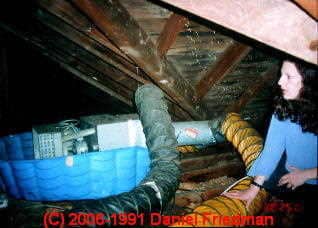 Do-It-Yourself Home made air conditioning systems can produce some systems that seem to cool the building but at high cost and with building damage, such as this goofy example may actually work but not without problems. This system used a window air conditioner placed in a home's attic. Do-It-Yourself Home made air conditioning systems can produce some systems that seem to cool the building but at high cost and with building damage, such as this goofy example may actually work but not without problems. This system used a window air conditioner placed in a home's attic.
Manhole ventilation duct (liberated from New York City) was used along with a home made hood attached to the air conditioner to blow cool air into the home through a ceiling register. The air conditioning condensate was collected in the blue plastic kiddie pool seen in the photo, and drained by gravity to a plumbing vent stack.
Nothing about the system was proper, safe, nor very effective, and in addition, the attic moisture conditions were terrible as you can see from the blackened plywood roof sheathing. The system was admirable for its creativity however. |
Other home made cooling systems such as evaporative coolers using a simple pan of water in front of a window fan can be effective and inexpensive in hot dry climates such as the southwestern United States
 Air-cooled air conditioner systems: refers to the use of air to cool the compressor and the condenser coil used to return the refrigerant gas to a liquid state.
Air-cooled air conditioner systems: refers to the use of air to cool the compressor and the condenser coil used to return the refrigerant gas to a liquid state. 

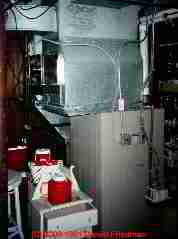
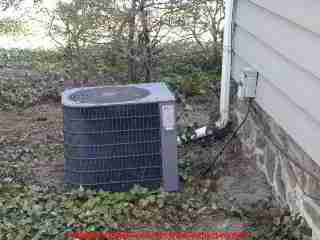
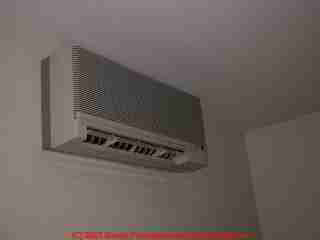
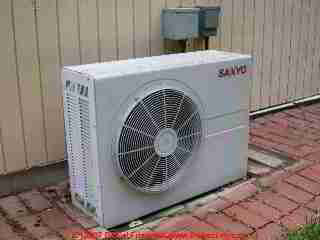

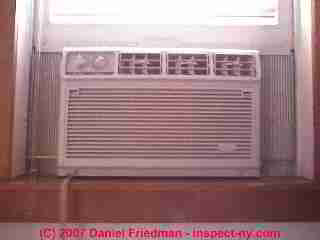
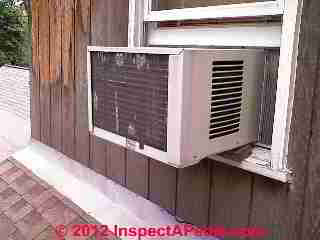








NYC AC units is one that could help and gives us solution to any issue of our air conditioning system. Our home need cooling system right?
ReplyDelete